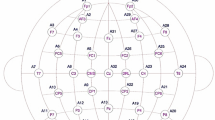Summary
-
1.
An ascending, auditory unit has been extracellularly recorded from the cervical connective in specimens of two tettigoniid species. Spike potentials arising from unilateral afferent input were monitored in response to airborne sounds in the frequency range 6.3–40 kHz and incident from different directions. Recordings were also obtained of the massed auditory response in the tympanal nerve in a third species.
-
2.
Frequency sensitivities of auditory organs were measured at threshold and suprathreshold levels. Optimum frequencies generally corresponded with energy peaks in relevant song spectra (Figs. 3, 4). Intensity characteristics of the ascending unit were obtained near the corresponding frequency optimum (Fig. 5). Directional sensitivities of the auditory organs near the frequency optima were measured at 15 ° intervals around the preparation at threshold and suprathreshold levels of stimulation (Fig. 6). Threshold sensitivities to ipsilateral and contralateral stimulation were compared over the range 6.3–40 kHz.
-
3.
Directional sensitivity of the ascending unit generally increased with increasing sound frequency. Maximum differences of from 8–25 dB were observed between sensitivities to ipsilateral and contralateral sound presentation in the frequency range 6.3–40 kHz (Fig. 8). Similar results were obtained for the massed primary response.
-
4.
The frequency sensitivity and the directional sensitivity of the auditory organs, for sound frequencies higher than 8–10 kHz (depending on species) and at threshold and suprathreshold levels, were found to be independent of pressure-gradient effects at the auditory tympana (Figs. 7, 8).
-
5.
The gross morphology of the prothoracic spiracle and associated trachea to the level of the tympanic membranes has been examined in each species. In the thorax, the trachea abruptly reduces in cross sectional area by about a factor of five. From the coxa to the distal femur the trachea undergoes a further three to four-fold reduction in cross section (Fig. 2).
-
6.
Physiological experiments and direct measurements using miniature probe microphones indicate that, in the frequency range 8–40 kHz (depending on species) the acoustic gain of the trachea leading from the prothoracic spiracle to the auditory tympana is 10–30 dB (Figs. 9, 10). The shape of the hearing threshold curve, however, only partially matches the gain curve of the trachea.
-
7.
Near the frequency optimum of the auditory organ, the sound pressure measured by a probe microphone in the thoracic tracheal vesicle adjacent to the prothoracic spiracle changes by 10–16 dB as a function of the direction of the incident sound (Fig. 12 A).
-
8.
Simultaneous measurements using two probe microphones show that relative sound pressure in the thoracic tracheal vesicle changes by 10–16 dB, whereas that in the trachea distal in the femur may change by 8–24 dB for different directions of sound (Fig. 12C). Directional sensitivities measured neurophysiologically are, therefore, fully explained by the relative sound pressure level in the fore-leg trachea leading to the auditory tympana.
-
9.
Dissimilarities sometimes observed between the directivity patterns of the sound pressures measured in the thoracic vesicle and in the femoral trachea possibly are due to the effects of sound entering the trachea along the length of the leg.
-
10.
These results are discussed in relation to the properties of acoustic horns and to other recent studies of auditory function in tettigoniids.
Similar content being viewed by others
References
Bailey WJ (1979) A review of Australian Copiphorini (Orthoptera: Tettigoniidae:Conocephalinae). Aust J Zool 27:1015–1049
Bailey WJ, Stephen RO (1978) Directionality and auditory slit function: A theory of hearing in bush crickets. Science 201:633–634
Ball EE, Hill KG (1978) Functional development of the auditory system of the cricket,Teleogryllus commodus. J Comp Physiol 127:131–138
Beranek L (1954) Acoustics. McGraw-Hill, New York
Boyan GS (1979) Directional responses to sound in the central nervous system of the cricketTeleogryllus commodus (Orthoptera: Gryllidae) I. Ascending interneurons. J Comp Physiol 130:137–150
Eibl E (1976) Morphologische und neuroanatomische Untersuchungen zur Sinnesorganausstattung der proximalen Tibienabschnitte und ihrer zentralen Projektionen bei Grillen. Dissertation Universität Köln
Field LH, Hill KG, Ball EE (1980) Physiological and biophysical properties of the auditory system of the New Zealand wetaHemideina crassidens. J Comp Physiol 141:31–37
Hill KG (1980) Physiological characteristics of auditory receptors inHemideina crassidens (Blanchard) (Ensifera: Stenopelmatidae). J Comp Physiol 141:39–46
Hill KG, Boyan GS (1977) Sensitivity to frequency and direction of sound in the auditory system of crickets (Gryllidae). J Comp Physiol 121:79–97
Kalmring K, Lewis B, Eichendorf A (1978) The physiological characteristics of the primary sensory neurons of the complex tibial organ ofDecticus verrucivorus L. (Orthoptera, Tettigonioidae). J Comp Physiol 127:109–121
Lewis DB (1974a) The physiology of the tettigoniid ear. I. The implications of the anatomy of the ear to its function in sound reception. J Exp Biol 60:821–837
Lewis DB (1974b) The physiology of the tettigoniid ear. IV. A new hypothesis for acoustic orientation behaviour. J Exp Biol 60:861–869
Morse PM (1948) Vibration and sound. McGraw-Hill, New York
Nocke H (1975) Physical and physiological properties of the tettigoniid (“grasshopper”) ear. J Comp Physiol 100:25–57
Seymour C, Lewis B, Larsen ON, Michelsen A (1978) Biophysics of the ensiferan ear II. The steady-state gain of the hearing trumpet in bush crickets. J Comp Physiol 123:205–216
Zeuner F (1936) The prothoracic tracheal apparatus of Saltatoria (Orthoptera). Proc R Entomol Soc (Lond) A 11:11–21
Author information
Authors and Affiliations
Additional information
We thank Professor Neville Fletcher and Dr. Peter McIntyre for advice on physics and mathematics.
Rights and permissions
About this article
Cite this article
Hill, K.G., Oldfield, B.P. Auditory function in tettigoniidae (Orthoptera:Ensifera). J. Comp. Physiol. 142, 169–180 (1981). https://doi.org/10.1007/BF00605735
Accepted:
Issue Date:
DOI: https://doi.org/10.1007/BF00605735




